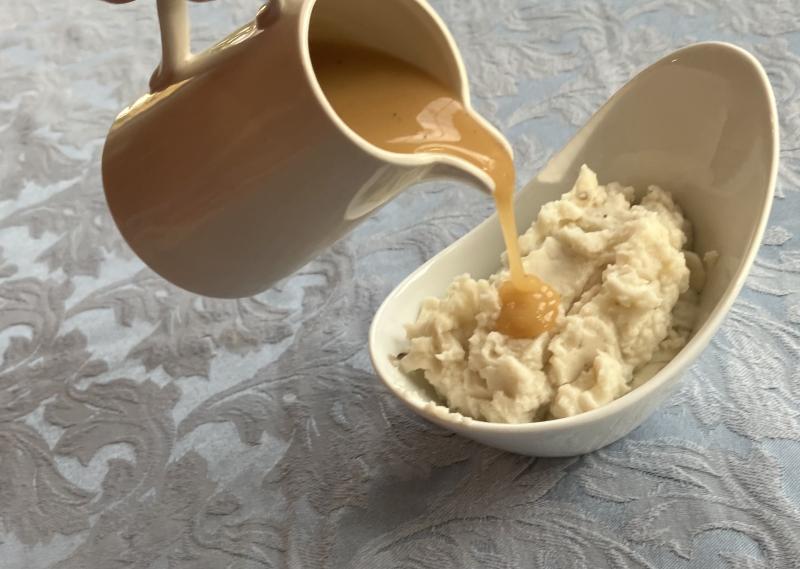Share:
Great gravy can make holiday meals memorable
November 4, 2022
We’ve just turned the calendar page to November. Halloween candy is on the discount shelf, days are getting shorter and grocery stores are stocking up on turkeys. As soon as we reach this point in the year, our thoughts gravitate toward holiday celebrations. From family gatherings to neighborhood parties, this is when menu planning becomes a full-time focus. One of the key elements of a fancy, multi-course meal will be great gravy. When serving multiple courses and dozens of dishes to a large group of people, there’s lots of pressure for everything to be ready at the right time, which often leaves gravy as an afterthought.
By way of definition, gravy is a sauce made from the juices and browned bits (called fond) left in the pan once you’ve roasted your chicken, chops or turkey. A chemical transformation of the proteins, through a process known as the Maillard reaction, creates rich morsels of flavor, the building blocks of wonderful gravy. There are three basic ingredients in gravy: fond, thickener and liquid; and three qualities to perfect gravy: color, texture and (of course) flavor.
Unless you’re making white gravy for chicken-fried steak or biscuits and sausage, you’ll want the gravy to have a rich color that echoes the poultry or meat it will accompany. Gravy for roast chicken or turkey should feature the dark-golden hues of the bird’s crispy skin. How do you accomplish this with flour as a thickener? Gently toast the flour in a dry skillet to remove the starchy flavor and add brown color.
As you have surely noticed, commercial chicken stock has almost no color, especially compared to a homemade bone broth simmered from a cooked chicken carcass. If that’s not an option, consider using a box of vegetable broth, which is typically made with carrots and onions, giving it a warm, brown color. And, the final color enhancer can be found in your roux. Once your melted butter and flour forms a paste, keep stirring until it turns a rich caramel color.
The next quality of good gravy is a silken texture, meaning no lumps. This starts when you deglaze the pan and scrape up the fond, incorporating it into the liquid. For ideal results, keep whisking to encourage these flavor morsels to dissolve completely. If the liquid mixture is gritty or fatty, first strain out any particles, then freeze for a few minutes so the fat can be skimmed off.
After this first stage of gravy-making, you’re ready to move on to the roux, again with nonstop stirring to prevent burning. As you pour the pan drippings into the roux, consider using an immersion blender or countertop blender to fully incorporate all the components. No matter the type of broth, you can also add a splash of wine during this step, which will add to the final quality of good gravy, flavor. Don’t forget salt and pepper, and a drop or two of soy or Worcestershire sauce which adds umami notes.
Since there is such a wide variety of gravy recipes, I’ve included a few for you to try during the next several weeks, from brunch-favorite sausage gravy to holiday-specialty turkey gravy.
Southern Sausage Gravy
1 lb bulk pork sausage
1/4 C flour
1 C milk
1 C half and half
1/8 t cayenne
salt and pepper, to taste
Crumble sausage in a large skillet over medium heat. Cook, breaking up meat with a spoon, until completely browned. Sprinkle flour over sausage and stir until dissolved, about 1 minute. Add milk and half and half. Simmer, whisking frequently, until the gravy is thick and bubbly (add more milk if consistency becomes too thick). Stir in cayenne and season to taste with salt and pepper. Serve over hot buttermilk biscuits.
Basic Gravy
1/2 C pan drippings
3 T butter
3 T flour
2 1/2 C broth
salt & pepper, to taste
To collect the pan drippings, deglaze the roasting pan with 1/2 C water or wine over medium heat, scraping up any browned bits from the bottom. Pour the mixture into a measuring cup through a strainer, and allow it to rest for 15 minutes so the fat will collect at the top. Discard fat and solids, reserving 1/2 C liquid; set aside. Melt butter in a heavy saucepan over medium. Stir in flour with a wooden spoon. Continue cooking until the paste is a deep-golden color. Pour in pan drippings and broth, whisking to combine. Season to taste with salt and pepper. Yield: 3 C.
Turkey Gravy
1 1/2 C broth
1/4 C flour
1/2 C dry white wine
salt and pepper, to taste
Once the turkey is done, remove it to a carving board and tent loosely with aluminum foil. Place the roasting pan on the stove over medium-high heat. Add the broth and begin scraping the browned bits from the bottom of the pan. Stir until the solids are dissolved. Pour the deglazed pan drippings into a glass measuring cup and place it in the freezer for 15 minutes. Remove the measuring cup from the freezer and lift off about 1/4 C of solidified fat, reserving the liquid below and discarding any excess fat (or save it for another use). Melt the fat in a saucepan over medium heat. Whisk in the flour to create a paste and cook, stirring continuously, until nicely browned. Pour the reserved pan drippings through a strainer into the saucepan. Whisk until combined and add the wine. Continue to cook, stirring often, until reduced to the desired thickness. Season to taste with salt and pepper; keep warm over very low heat.
























































